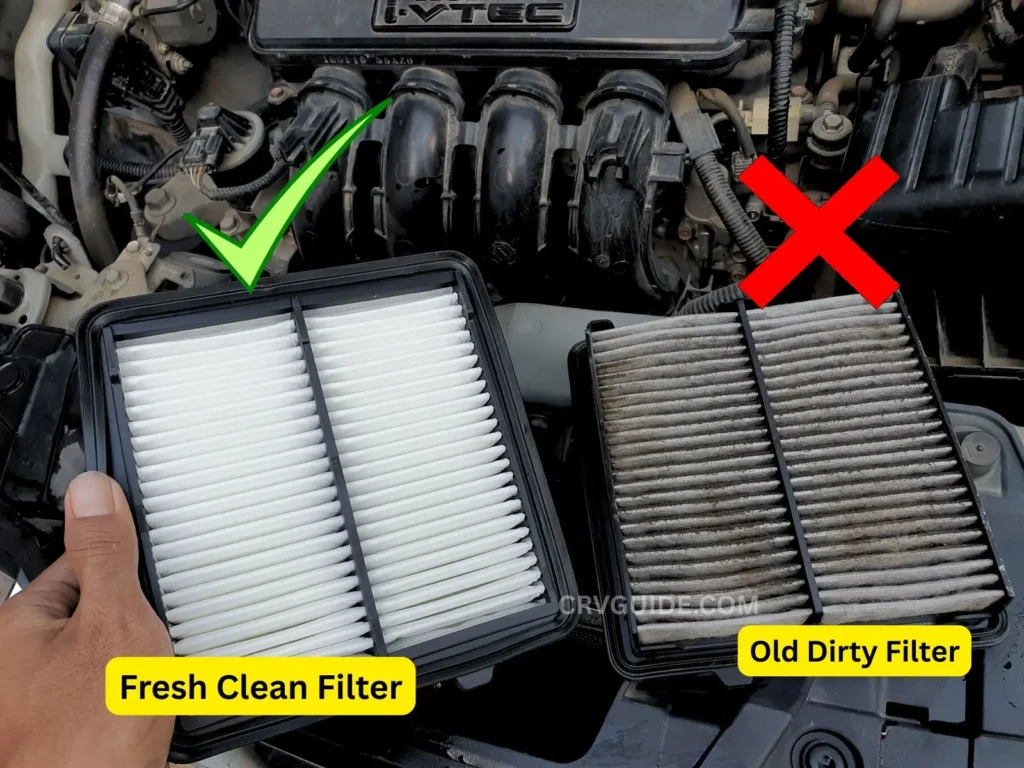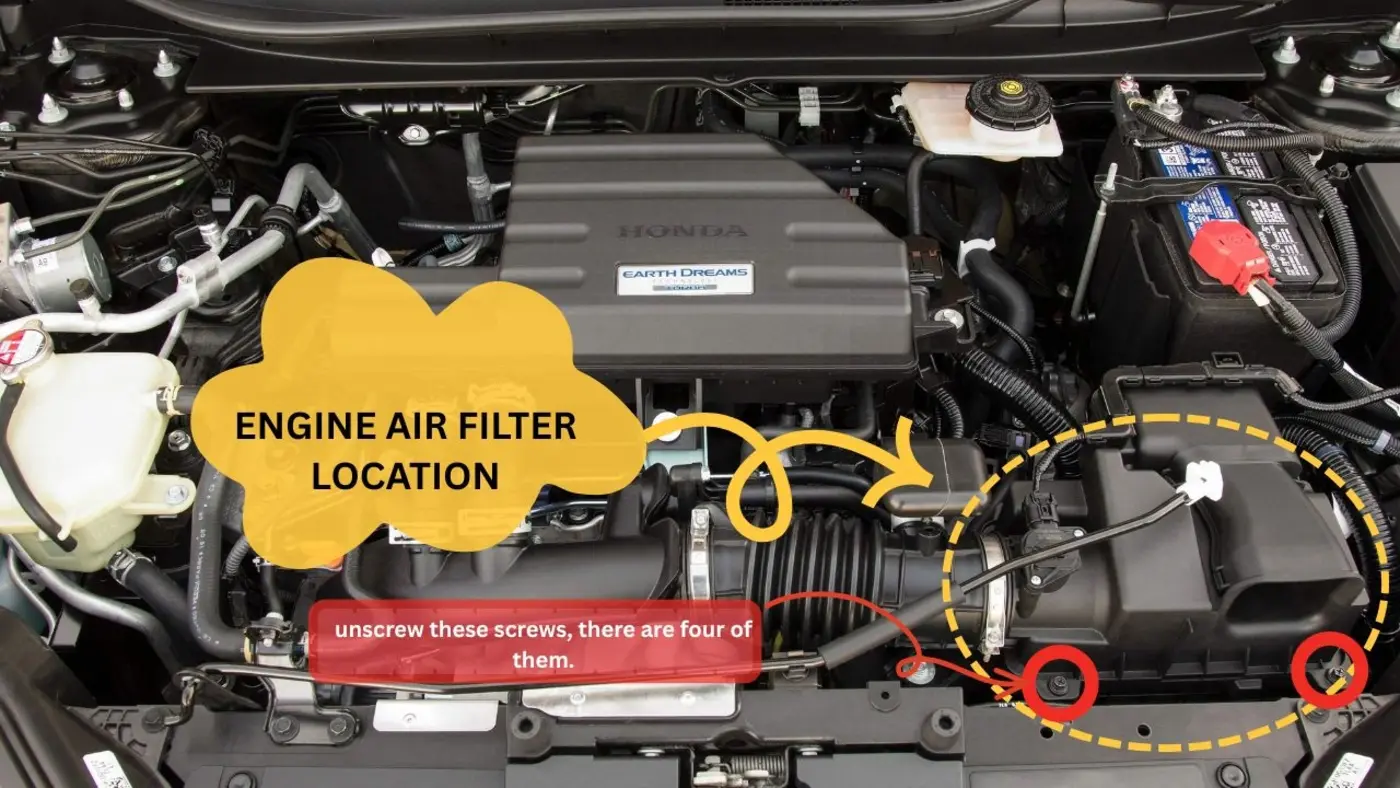CR-V Engine Air Filter Replacement (When, How, Cost)
The Honda CR-V is known for its reputation as one of the most reliable vehicles.
But, like a well-oiled machine, it will be a reliable companion in all conditions if you take good care of it. Quite often overlooked, but playing a vital role, is the humble engine air filter.
These small components that cost no more than a box of pizza play a huge role in your SUV’s overall performance, fuel efficiency, and longevity.
In this comprehensive guide, I will explain why you should pay attention to your CR-V’s engine air filter and show you the signs that it needs to be replaced.
In addition, I will also provide a step-by-step guide on how to inspect and replace the engine air filter yourself at home, as well as other helpful information to keep your CR-V engine running smoothly.

What is an Engine Air Filter?
In short, the engine air filter is a device that filters air. Which air? Air that will enter the combustion chamber.
You need to know that the Honda CR-V (and most modern cars) has an internal combustion engine (ICE) that requires air for combustion or burning.
The engine needs a smooth flow of clean air to work optimally in combustion. This is where the engine air filter comes into play. It cleans the air by capturing dust, dirt, and other contaminants before they enter the combustion chamber.
A clean air filter ensures smooth, fresh air flow into the combustion chamber, improving engine performance and longevity.
You need to know that this Engine Air Filter differs from the cabin air filter. Although both are responsible for filtering air, they are two different species.
The engine air filter filters the air that enters the combustion chamber, while the cabin air filter cleans the air that enters the car interior.
On the Honda CR-V, the Engine Air Filter is located under the hood, near the engine air intake. In contrast, the cabin air filter is located inside the cabin, precisely under the glove compartment.
I must explain this because many of us still mistakenly think that the engine air filter is the same device as the cabin air filter.
Why Your CR-V’s Engine Air Filter is Crucial
As I mentioned earlier, the primary function of the engine air filter is to prevent dust, dirt, debris, and other contaminants from entering the engine.
Clean air is essential for optimal combustion. Therefore, a clean and good-condition air filter ensures that clean air can enter the combustion chamber smoothly.
Over time, the air filter becomes dirty due to particle buildup. When that happens, the air entering the combustion chamber is obstructed, which affects the combustion process.
A clean engine air filter will ensure clean air enters the combustion chamber smoothly. When that happens, you have ensured the combustion process is optimised, which in turn will have several positive impacts on the vehicle, including:
- Improved fuel economy
- Enhanced engine performance
- Extended engine life
- Reduced emissions.
It’s clear that the engine air filter plays a pretty important role in a vehicle’s engine system. Although it’s not the only one, ensuring the cleanliness of the engine air filter is one factor in ensuring the engine runs smoothly and lasts longer.
Symptoms of a Dirty Engine Air Filter
Several common signs will appear when the engine air filter is dirty. Here are some of them.
- Sluggish Acceleration
- Bad fuel economy
- Rough idle or misfires
- The check engine light comes on
Some of the symptoms above may be similar to problems caused by other things. But when you feel one or more of the symptoms above, it might be a sign that it’s time for you to check the engine air filter.
When to Check and Replace
So, when or how long should you replace the engine air filter? Well, the Honda CR-V owner’s manual does not explicitly provide information on this.
However, the owner’s manual says that if you drive in dusty conditions, you need to change the air cleaner element every 15,000 miles.
I suggest you check the condition of the air filter every time you do an engine oil change, which, according to the maintenance schedule, is every 7,500 miles or 1 year, whichever comes first.
Checking the engine air filter may also be necessary whenever you feel that you have one or more of the symptoms of a dirty air filter, as discussed earlier.
If you find your engine air filter is already in a dirty condition as seen in the photo below, it might be worth getting a replacement as soon as possible.

Since checking the engine air filter is easy, I’m confident anyone can do it. In the next section, we’ll discuss doing a DIY filter check and change in more detail.
Step-by-Step Guide: DIY Replacement
I’ve always mentioned how easy it is to change the engine air filter, but how do you do it? What are the tools needed?
Well, in my experience, the process is quite simple and doesn’t require many tools, all you need is a Phillips screwdriver, a rag, and a new filter to replace the old one.
I believe everyone has a Phillips screwdriver and a rag, right?
Once you have all the tools and the new filter, all you have to do is open the hood, find the filter location, unscrew a few screws, open the filter housing, and do the replacement. it’s that simple.

Step-by-step guide to replacing the engine air filter:
- Park the car in a flat place that is free of dust.
- Gather your tools, you’ll need a Phillips screwdriver, a rag, and a new filter.
- Open the hood, preferably when the engine is cold. locate the filter housing and screw locations. if the housing is dirty with dust, wipe the housing so that dust does not contaminate the new filter during installation.
- loosen the screws, there are four captive screws on the filter housing that need to be unscrewed.
- When the screws are loose, lift the air filter housing to gain access to the old filter.
- Carefully remove the old filter. Then install the new filter, making sure it is seated properly and in the correct orientation.
- Reinstall the housing, making sure the air line tube behind the housing is pressed back to its connection point and is well connected.
- Tighten the four screws, making sure they are properly threaded so that the housing is securely closed.
- done, now your Honda CR-V breathes smoothly and gets fresher air.
Cost To Replace
According to repairpal.com, the average Honda CR-V engine air filter replacement cost ranges between $56 and $87. Labor costs are estimated between $31 and $41, which is about half of the total cost.
You can save a bit by finding a local garage, they usually tend to charge less for labor, and some even offer free installation as long as you buy the part from them.
Another way to save money is to install it yourself. You can get a new engine air filter online and install it at home.
By doing the replacement by yourself, you can eliminate the labor cost. With only around $20, you can get a fresh new filter for your CR-V.
Compared to replacing at the dealer, which costs over $50, doing the replacement yourself at home will save you up to $40 in labor costs. That money can be used to get a better air filter; these filters usually have a higher price than the standard model the dealer provides.
Please note that there are several types of filters that are commonly used, including paper air filters, cotton air filters, and synthetic air filters. They have their own characteristics and advantages.
Paper Air Filter
This is the most commonly used filter, including dealer-supplied models, which are relatively cheaper than other types. This type of filter is disposable, it cannot be cleaned and reused. In addition, this type of filter also tends to need to be replaced more often, but fortunately, the price is cheap.
Cotton Air Filter
Made of oiled cotton cloth, it has better filtering performance and is more durable. This filter can be cleaned and reused, making it cost-effective in the long run, however the price is quite high.
Synthetic Air Filter
This type of filter is made of synthetic materials, their main advantage is that they have excellent filtration and good durability. They are also resistant to extreme temperatures, but require more frequent maintenance and are much more expensive than paper filters.
(mospart)
I always go for paper air filters, they are easy to find and very affordable. Last time, I got a FRAM brand air filter for no more than $20 from an online store, even with free shipping.
Since it’s cheap, and I can do the changing process by myself, I can do engine air filter changes 2 to 3 times a year. well, that might be too often, but I’m happy to do it. I even have a few spare air filters at home. LOL
Frequently Asked Questions
Fresh Air: Healthy Engine
Finally, we have discussed quite a lot regarding the engine air filter on the Honda CR-V.
In conclusion, the engine air filter is vital to your CR-V. Ignoring the air filter’s condition means you ignore your car’s health. A dirty engine air filter will have a bad impact on your engine, the most noticeable is that performance will decrease, and fuel consumption will increase.
The air filter is like a mask that we wear when we are in a dusty place. If our mask is dirty, you can imagine how our breathing would be affected. That’s also the role of the engine air filter on your CR-V.
By regularly checking and replacing according to Honda’s recommendations, you ensure your Honda CR-V gets a smooth supply of clean air, which in turn will make your car last longer on the road.
If you have any further questions about the engine air filter or want to share your experience, please drop it in the comment section!
